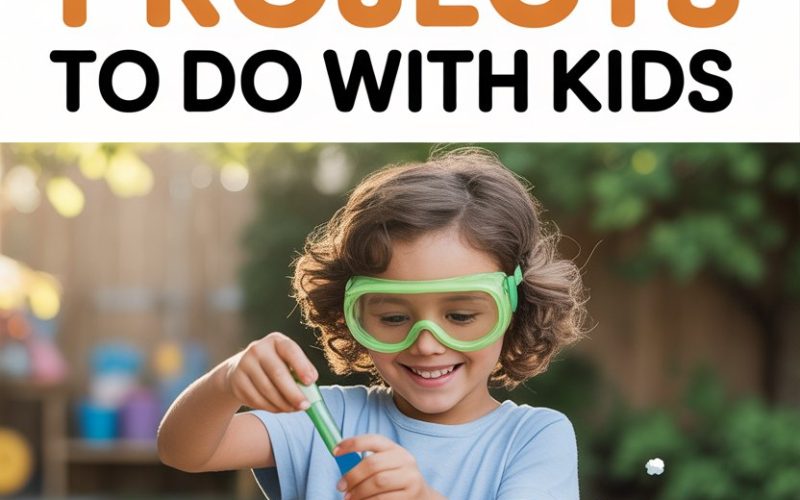Sun’s out, kids are home, and if you’re anything like me, your pantry is already teetering on the edge after “snack time.”
Summer doesn’t have to be a three-month loop of snacks, screen time, and negotiating bedtime, though.
Science projects can rescue you from the perpetual chorus of “I’m bored” and add a splash of learning—without the need for a PhD or a spare laboratory.
Here’s a list of 25 science projects busy parents can actually pull off, using things you probably have lying around.
1. Rainbow Walking Water
Kids adore magic. This one looks like magic but it’s really capillary action at work. Line up six cups: fill the first, third, and fifth with water and add food coloring (red, yellow, blue).
Position folded paper towels between each cup so they’re dipping into the liquid. Soon, the colors ‘walk’ and create a rainbow effect. Here’s a quick how-to for reference.
2. Solar Oven S’mores
Solar power: it’s not just for saving the planet, it’s for gooey desserts. Wrap a pizza box in foil, cut a flap in the lid, and line the bottom with black paper.
Place marshmallows and chocolate on biscuits (or graham crackers if you’re stateside), close the lid with a clear plastic wrap, and angle the flap to reflect sunlight.
Wait, then bask in the glory of sun-baked s’mores. NASA’s site has a full guide.
3. DIY Tornado in a Bottle
The fastest way to capture a child’s attention? Swirling chaos in a bottle. Fill a plastic bottle with water, add a squirt of dish soap, and sprinkle in a bit of glitter.
Swirl it, flip it, and…tornado! They’ll want to “do it again!” for the next hour. Watch it in action.
4. Edible Rock Candy Crystals
Science that ends in sugar is always a win. Dissolve heaps of sugar in hot water, add food coloring, and hang a string or wooden skewer in the jar.
Wait a week—if you can resist checking every five minutes—and watch those crystals grow. Try this method.
5. Balloon Rocket Races
Thread a piece of string through a straw and secure each end to chairs a few metres apart. Inflate a balloon (don’t tie it), tape it to the straw, and let it go.
Newton’s Third Law gets a workout. Sibling rivalry thrown in at no extra charge. Find more details here.
6. Homemade Lava Lamps
Clear bottle, water, oil, food coloring, plus a fizzy tablet (like Alka-Seltzer). When you drop in the tablet, bubbles galore. It’s mesmerizing, simple, and doubles as a party trick. Check out this step-by-step.
7. Plant Maze Challenge
Grab a cardboard box, cut windows for light, and create a zig-zag maze inside. Place a potted bean sprout at the bottom.
Over days, watch it twist and turn toward the sunlight. It’s a living example of phototropism. Yes, your kitchen becomes a jungle.
8. Frozen Dinosaur Eggs
Freeze small plastic dinosaurs in balloons filled with water. In the morning, peel off the balloons and hand out salt, warm water, and pipettes.
Kids “excavate” their dinos—a lesson in melting and a chance for dramatic paleontologist role-play. Here’s how.
9. Egg Drop Challenge
Give your budding engineers some basic supplies: straws, tape, bubble wrap, and a raw egg. The goal? Create a “spaceship” that keeps the egg from cracking when dropped from a height.
Test outside—unless you fancy scrambled eggs on the rug. Ideas and rules here.
10. Sun Prints
All you need is construction paper and a few interesting objects (leaves, keys, toys). Arrange items on the paper, leave it in the sun, and watch as the sun bleaches around the shapes.
Your kids have just discovered UV light’s power, and you get free abstract art for the fridge. Learn more here.
11. Kitchen Volcano
This one’s a classic. Pile up play dough around a small container, spoon in some baking soda, and pour in vinegar tinted with red food coloring. The foamy “lava” will have toddlers cackling like mad scientists. See how it works.
12. Water Xylophone
Line up jars, fill them with varying amounts of water, and hand your child a spoon. Plink, plonk, science!
Changing the water level changes the pitch, and you, my friend, now have a junior physicist (and possibly a headache). Instructions here.
13. Butterfly Life Cycle Kit
Order a butterfly kit (with live caterpillars) and watch as small wriggling creatures munch, pupate, and flutter out as butterflies. It’s a front-row seat to metamorphosis. Butterfly kits are easy to find.
14. Rain in a Jar
Boil water and pour it into a jar. Top with a plate full of ice cubes. In a few minutes, water droplets “rain” down the inside—demonstrating how clouds and rain form.
It’s a speedy lesson in the water cycle, minus the soggy trousers. Try this method.
15. Magnetic Treasure Hunt
Scatter paper clips and metal odds ‘n ends in a tub of rice. Give your child a magnet and challenge them to fish out the “treasure.”
This hands-on experiment explores magnetism and, incidentally, might buy you two blessed minutes of peace. How-to here.
16. Bubble Science Bonanza
Mix up a batch of bubble solution (water, washing-up liquid, a splash of glycerin if you’ve got it). Use straws, pipe cleaners, and anything round to test different bubble wands.
Which shape makes the best bubbles? Try catching a bubble on your palm—if you dare. Great bubble recipe here.
17. Nature Scavenger Hunt
Hand out a list: a round leaf, something fuzzy, a rock with stripes. Encourage collecting, sorting, and identifying finds. Sneaky science: classification, observation, and a surprise dose of P.E. Printable ideas here.
18. Penny Cleaning Chemistry
Set up a “spa day” for filthy coins. Put vinegar and salt in one cup, plain water in another. Drop pennies in both and compare results.
The shine is down to simple chemistry—acids removing copper oxide. Learn more here.
19. Soda Geyser Spectacular
Arguably the most dramatic science trick short of launching a rocket. Drop Mentos sweets into a bottle of fizzy drink (do it outside—trust me on this), and watch the fountain shoot up impressively high. See the explanation.
20. Simple Circuit Bugs
Pick up a pack of LED lights, some coin batteries, and pipe cleaners. Help your child make a “bug” by twisting the pipe cleaners, then tape the LED legs to the battery. Voila—your bug glows! Step-by-step guide.
21. Growing Avocado Pits
Jam three toothpicks into an avocado seed and suspend it over a glass of water. Roots and shoots will appear in a week or two.
With luck, you’ll have a dramatic new houseplant and a reason to keep making guacamole. Tips here.
22. Oobleck: Non-Newtonian Slime
Mix two parts cornflour with one part water. It’s a solid when squeezed, a liquid when you let go. Kids can’t get enough of this gooey weirdness, and it’s a practical lesson in physics. Recipe and details.
23. DIY Barometer
Kids love being the weatherperson. Fill a small jar with water, cover the opening with a balloon stretched tight, secure with a rubber band, and tape a straw flat across the top.
When air pressure changes, the straw moves up or down. Science made simple.
24. Make a Cloud in a Bottle
Pour a splash of warm water into a plastic bottle, light a match (grown-ups only), drop it in, quickly screw on the lid, and squeeze the bottle hard. Release and—poof!—clouds!
Turn your kitchen into a meteorology lab. Guide here.
25. Static Electricity Butterflies
Cut a butterfly out of tissue paper and stick it to a table with a bit of tape. Charge a balloon by rubbing it on hair or wool, then hold it above the butterfly.
Watch the wings flutter up! This project never gets old, and it’s a cheerful way to introduce static electricity. Instructions.
Keeping Science Fun and Manageable
Science projects don’t always require fancy equipment or hours of prep (though a roll of kitchen towels for spills is your new best friend).
The best experiments are those that fit real life—messy kitchens, short attention spans, and all.
Kids remember summer moments like these for years: the fizz of a “volcano,” the surprise of a sprouting pit, or the taste of a solar-cooked s’more.
You don’t have to be a science whiz to make it happen. You just need a pinch of curiosity (and maybe a broom).
Ready to make a little scientific magic? Go grab those supplies. Your living room is about to get a whole lot more interesting.





